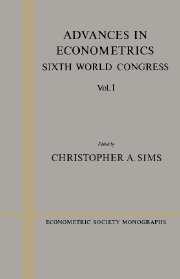7 - On the economics and econometrics of seasonality
Published online by Cambridge University Press: 05 January 2013
Summary
INTRODUCTION
In order to understand and formulate economic theories, we tend to classify the types of movements which characterize economic time series as trend, cyclical, seasonal, and irregular. The idea that each component has separate and different causal forces is implicit in many of the discussions on the decomposition. Among the four components, two were considered to be of prime interest to economists. Whereas theories of economic growth suggest models which explain the secular or trend component of economic aggregates, the bulk of macroeconomics focuses on models explaining the stylized facts of the reoccurring cyclical component. The other two components, namely the seasonal and the irregular, were mostly viewed as a nuisance and of no major interest to us economists for the simple reason that we have almost no theoretical developments on economic models of seasonality. Consequently, without any interest in seasonality and considering that it was common until recently to separate growth models from business cycle models, the large majority of empirical macroeconomics has adopted a strategy of seasonally adjusting and detrending each series separately prior to any inference about the business cycle.
Lately economic theorists studying stochastic growth theory have suggested models integrating the growth and cyclical components of economic time series, viewing expansions and contractions simply as the acceleration and the slowing down of the overall economic growth process. Time series econometricians, on the other hand, focused their attention on the econometric estimation and testing of parametric models with trending processes. Nowadays empirical macroeconomists tend to be more careful about trends and pay more attention to issues such as common trends and the interaction of cyclical and secular fluctuations.
- Type
- Chapter
- Information
- Advances in EconometricsSixth World Congress, pp. 257 - 322Publisher: Cambridge University PressPrint publication year: 1994
- 14
- Cited by

